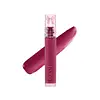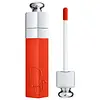What's inside
What's inside
 Key Ingredients
Key Ingredients

 Benefits
Benefits

 Concerns
Concerns

 Ingredients Side-by-side
Ingredients Side-by-side

Water
Skin ConditioningTrimethylsiloxyphenyl Dimethicone
Octyldodecanol
EmollientPolybutene
Bis-Behenyl/Isostearyl/Phytosteryl Dimer Dilinoleyl Dimer Dilinoleate
EmollientDiisostearyl Malate
EmollientPolyamide-8
EmollientPolysorbate 60
EmulsifyingButylene Glycol
HumectantCetyl Alcohol
EmollientPolyglycerin-3
HumectantSorbitan Sesquioleate
EmulsifyingAlcohol Denat.
AntimicrobialGlycerin
HumectantHydroxyethyl Acrylate/Sodium Acryloyldimethyl Taurate Copolymer
Emulsion StabilisingCoco-Caprylate/Caprate
Emollient1,2-Hexanediol
Skin ConditioningCastor Oil/Ipdi Copolymer
Caprylyl Glycol
EmollientCaprylic/Capric/Succinic Triglyceride
EmollientCI 17200
Cosmetic ColorantEthylhexylglycerin
Skin ConditioningCaprylic/Capric Triglyceride
MaskingCI 15985
Cosmetic ColorantSorbitan Isostearate
EmulsifyingTocopherol
AntioxidantDehydroacetic Acid
PreservativeSodium Phytate
Polyacrylate-13
Parfum
MaskingPolyisobutene
Hydrolyzed Hyaluronic Acid
HumectantCI 42090
Cosmetic ColorantPentaerythrityl Tetra-Di-T-Butyl Hydroxyhydrocinnamate
AntioxidantPolysorbate 20
EmulsifyingRubus Idaeus Leaf Extract
Skin ConditioningWater, Trimethylsiloxyphenyl Dimethicone, Octyldodecanol, Polybutene, Bis-Behenyl/Isostearyl/Phytosteryl Dimer Dilinoleyl Dimer Dilinoleate, Diisostearyl Malate, Polyamide-8, Polysorbate 60, Butylene Glycol, Cetyl Alcohol, Polyglycerin-3, Sorbitan Sesquioleate, Alcohol Denat., Glycerin, Hydroxyethyl Acrylate/Sodium Acryloyldimethyl Taurate Copolymer, Coco-Caprylate/Caprate, 1,2-Hexanediol, Castor Oil/Ipdi Copolymer, Caprylyl Glycol, Caprylic/Capric/Succinic Triglyceride, CI 17200, Ethylhexylglycerin, Caprylic/Capric Triglyceride, CI 15985, Sorbitan Isostearate, Tocopherol, Dehydroacetic Acid, Sodium Phytate, Polyacrylate-13, Parfum, Polyisobutene, Hydrolyzed Hyaluronic Acid, CI 42090, Pentaerythrityl Tetra-Di-T-Butyl Hydroxyhydrocinnamate, Polysorbate 20, Rubus Idaeus Leaf Extract
Water
Skin ConditioningGlycerin
HumectantMethyl Hydrogenated Rosinate
PerfumingButylene Glycol
HumectantPolyglyceryl-2 Triisostearate
EmulsifyingAlcohol
AntimicrobialPolyglycerin-3
HumectantHydroxyethyl Acrylate/Sodium Acryloyldimethyl Taurate Copolymer
Emulsion StabilisingSqualane
EmollientPolyurethane-35
1,2-Hexanediol
Skin ConditioningLecithin
EmollientMenthoxypropanediol
MaskingParfum
MaskingTrimethylolpropane Triisostearate
EmollientSodium Hyaluronate
HumectantPolysorbate 60
EmulsifyingHydroxyacetophenone
AntioxidantSodium Benzoate
MaskingPrunus Avium Seed Oil
EmollientAmmonium Glycyrrhizate
MaskingSorbitan Isostearate
EmulsifyingTocopherol
AntioxidantMethylpropanediol
SolventEthyl Vanillin
MaskingCitric Acid
BufferingCaprylyl Glycol
EmollientCapsicum Frutescens Fruit Extract
Skin ConditioningPropyl Gallate
AntioxidantPhenylpropanol
MaskingPentaerythrityl Tetra-Di-T-Butyl Hydroxyhydrocinnamate
AntioxidantCI 73360
Cosmetic ColorantCI 15985
Cosmetic ColorantCI 15850
Cosmetic ColorantCI 45410
Cosmetic ColorantCI 17200
Cosmetic ColorantWater, Glycerin, Methyl Hydrogenated Rosinate, Butylene Glycol, Polyglyceryl-2 Triisostearate, Alcohol, Polyglycerin-3, Hydroxyethyl Acrylate/Sodium Acryloyldimethyl Taurate Copolymer, Squalane, Polyurethane-35, 1,2-Hexanediol, Lecithin, Menthoxypropanediol, Parfum, Trimethylolpropane Triisostearate, Sodium Hyaluronate, Polysorbate 60, Hydroxyacetophenone, Sodium Benzoate, Prunus Avium Seed Oil, Ammonium Glycyrrhizate, Sorbitan Isostearate, Tocopherol, Methylpropanediol, Ethyl Vanillin, Citric Acid, Caprylyl Glycol, Capsicum Frutescens Fruit Extract, Propyl Gallate, Phenylpropanol, Pentaerythrityl Tetra-Di-T-Butyl Hydroxyhydrocinnamate, CI 73360, CI 15985, CI 15850, CI 45410, CI 17200
Ingredients Explained
These ingredients are found in both products.
Ingredients higher up in an ingredient list are typically present in a larger amount.
1,2-Hexanediol is a synthetic liquid and another multi-functional powerhouse.
It is a:
- Humectant, drawing moisture into the skin
- Emollient, helping to soften skin
- Solvent, dispersing and stabilizing formulas
- Preservative booster, enhancing the antimicrobial activity of other preservatives
Butylene Glycol (or BG) is used within cosmetic products for a few different reasons:
Overall, Butylene Glycol is a safe and well-rounded ingredient that works well with other ingredients.
Though this ingredient works well with most skin types, some people with sensitive skin may experience a reaction such as allergic rashes, closed comedones, or itchiness.
Learn more about Butylene GlycolCaprylyl Glycol is a humectant and emollient, meaning it attracts and preserves moisture.
It is a common ingredient in many products, especially those designed to hydrate skin. The primary benefits are retaining moisture, skin softening, and promoting a healthy skin barrier.
Though Caprylyl Glycol is an alcohol derived from fatty acids, it is not the kind that can dry out skin.
This ingredient is also used as a preservative to extend the life of products. It has slight antimicrobial properties.
Learn more about Caprylyl GlycolCi 15985 is a dye made from petroleum. It is synthetically created and approved by the FDA for use in foods and cosmetics.
The color of this dye is orange/yellow.
This ingredient can be found in makeup, sun care, and skincare.
Learn more about CI 15985Ci 17200 is a synthetic reddish-purple dye.
Glycerin is already naturally found in your skin. It helps moisturize and protect your skin.
A study from 2016 found glycerin to be more effective as a humectant than AHAs and hyaluronic acid.
As a humectant, it helps the skin stay hydrated by pulling moisture to your skin. The low molecular weight of glycerin allows it to pull moisture into the deeper layers of your skin.
Hydrated skin improves your skin barrier; Your skin barrier helps protect against irritants and bacteria.
Glycerin has also been found to have antimicrobial and antiviral properties. Due to these properties, glycerin is often used in wound and burn treatments.
In cosmetics, glycerin is usually derived from plants such as soybean or palm. However, it can also be sourced from animals, such as tallow or animal fat.
This ingredient is organic, colorless, odorless, and non-toxic.
Glycerin is the name for this ingredient in American English. British English uses Glycerol/Glycerine.
Learn more about GlycerinThis is a synthetic polymer. It helps improve the texture of products by adding thickness and gel-like feel.
It is also an emulsifer, meaning it prevents ingredients such as oil and water from separating. It also helps evenly disperse other ingredients.
Parfum is a catch-all term for an ingredient or more that is used to give a scent to products.
Also called "fragrance", this ingredient can be a blend of hundreds of chemicals or plant oils. This means every product with "fragrance" or "parfum" in the ingredients list is a different mixture.
For instance, Habanolide is a proprietary trade name for a specific aroma chemical. When used as a fragrance ingredient in cosmetics, most aroma chemicals fall under the broad labeling category of “FRAGRANCE” or “PARFUM” according to EU and US regulations.
The term 'parfum' or 'fragrance' is not regulated in many countries. In many cases, it is up to the brand to define this term.
For instance, many brands choose to label themselves as "fragrance-free" because they are not using synthetic fragrances. However, their products may still contain ingredients such as essential oils that are considered a fragrance by INCI standards.
One example is Calendula flower extract. Calendula is an essential oil that still imparts a scent or 'fragrance'.
Depending on the blend, the ingredients in the mixture can cause allergies and sensitivities on the skin. Some ingredients that are known EU allergens include linalool and citronellol.
Parfum can also be used to mask or cover an unpleasant scent.
The bottom line is: not all fragrances/parfum/ingredients are created equally. If you are worried about fragrances, we recommend taking a closer look at an ingredient. And of course, we always recommend speaking with a professional.
Learn more about ParfumPentaerythrityl Tetra-Di-T-Butyl Hydroxyhydrocinnamate (long name, huh?) is a synthetic antioxidant.
It is used to help stabilize other antioxidants or prevent the color from changing in a product.
As an antioxidant, it helps fight free-radical molecules. Free-radical molecules are capable of damaging our cells and other genetic material. Thus, antioxidants may reduce the signs of aging.
This ingredient is oil-soluble.
Learn more about Pentaerythrityl Tetra-Di-T-Butyl HydroxyhydrocinnamatePolyglycerin-3 is a 3-unit glycerin polymer.
Like glycerin, this ingredient is a humectant. Humectants help hydrate your skin by drawing water to it.
Having moisturized skin helps improve the skin barrier. Your skin barrier helps protect against irritants and bacteria.
Learn more about Polyglycerin-3Polysorbate 60 is used to help stabilize products. It is a surfactant and emulsifier. These properties help keep ingredients together in a product. Surfactants help reduce surface tension between ingredients with different states, such as liquids and solids. Emulsifiers help prevent oils and waters from separating.
Polysorbate 60 is sorbitol-based and created from the ethoxylation of sorbitan. Ethoxylation is a chemical reaction used to add ethylene oxide. Sorbitan is a the dehydrated version of sorbitol, a sugar found in fruits.
In this case, the 60 comes from reacting 60 units of ethylene oxide with sorbitan.
Polysorbates are commonly used in medicine and foods.
Learn more about Polysorbate 60Sorbitan Isostearate is an emulsifer and cleaning agent. It is created from isostearic acid and sorbitol.
As an emulsifier, Sorbitan Isostearate prevents oils and water from separating.
Due to its isostearic acid base, it may not be safe for Malassezia or fungal acne.
Learn more about Sorbitan IsostearateTocopherol (also known as Vitamin E) is a common antioxidant used to help protect the skin from free-radicals and strengthen the skin barrier. It's also fat soluble - this means our skin is great at absorbing it.
Vitamin E also helps keep your natural skin lipids healthy. Your lipid skin barrier naturally consists of lipids, ceramides, and fatty acids. Vitamin E offers extra protection for your skin’s lipid barrier, keeping your skin healthy and nourished.
Another benefit is a bit of UV protection. Vitamin E helps reduce the damage caused by UVB rays. (It should not replace your sunscreen). Combining it with Vitamin C can decrease sunburned cells and hyperpigmentation after UV exposure.
You might have noticed Vitamin E + C often paired together. This is because it is great at stabilizing Vitamin C. Using the two together helps increase the effectiveness of both ingredients.
There are often claims that Vitamin E can reduce/prevent scarring, but these claims haven't been confirmed by scientific research.
Learn more about TocopherolWater. It's the most common cosmetic ingredient of all. You'll usually see it at the top of ingredient lists, meaning that it makes up the largest part of the product.
So why is it so popular? Water most often acts as a solvent - this means that it helps dissolve other ingredients into the formulation.
You'll also recognize water as that liquid we all need to stay alive. If you see this, drink a glass of water. Stay hydrated!
Learn more about Water